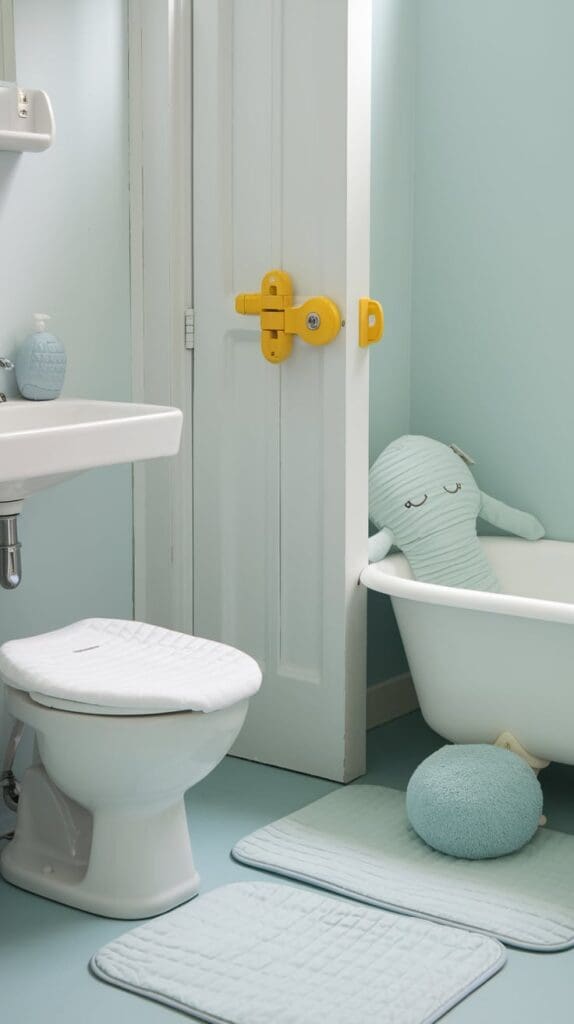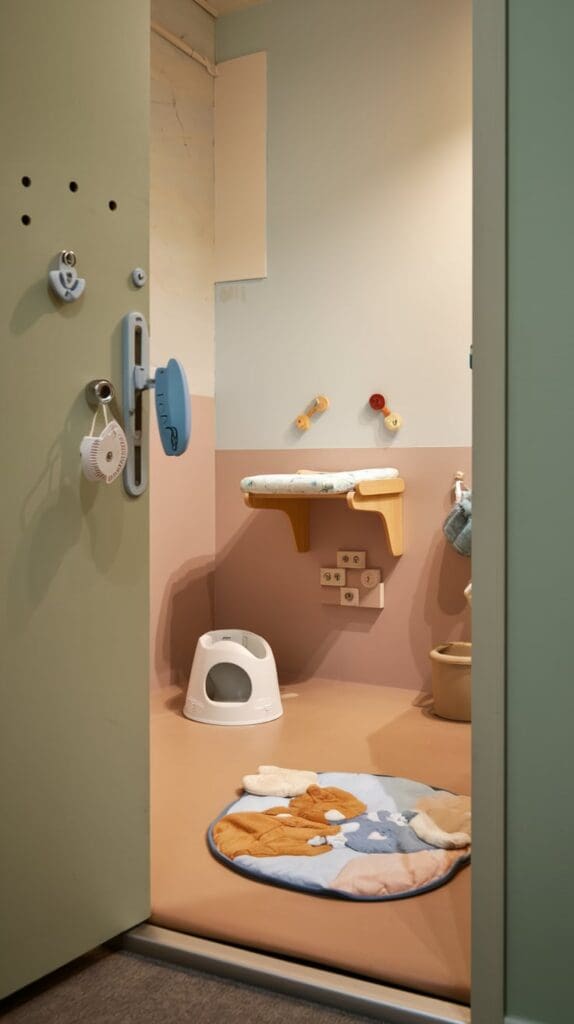Bathroom Safety for Kids: 12 Essential Tips for a Safer Home
Worried about bathroom accidents with your little one? This guide covers 12 essential bathroom safety tips for kids — from anti-slip solutions to burn prevention — and includes trusted product recommendations to help you create a safer space today.
When it comes to bathroom safety for kids, a few smart changes can prevent major accidents and give parents peace of mind.
Heads up: This post may include affiliate links. As an Amazon Associate, I earn from qualifying purchases—at no extra cost to you. Full privacy policy and disclosure here.

Why Bathroom Safety for Kids Matters
The bathroom can be one of the most dangerous places in your home for young children. With slippery surfaces, hard fixtures, and access to cleaning products or hot water, it’s crucial to take preventative measures before accidents happen. Whether you’re parenting a curious toddler or an independent preschooler, these tips will help make your bathroom a much safer space.
1. Use a Non-Slip Bath Mat
Slipping is one of the most common bathroom hazards for children.
- Choose a non-slip bath mat for both inside and outside the tub
- Look for options with suction cups for maximum grip
- Example: Gorilla Grip Bath Mat
Bonus Tip: Place a second mat near the sink if water often pools there.
This is one of the simplest upgrades you can make to improve bathroom safety for kids in homes with slippery tubs.
2. Install a Toilet Seat Lock
Toddlers are especially fascinated by toilets (and yes, they’ve been known to toss in toys).
- Prevent accidental drowning or messy cleanups with a toilet seat lock
- Easy to install and keeps the lid securely closed
- Try the Munchkin Toilet Lock
A toilet seat lock is a must-have when thinking about bathroom safety for kids — especially curious toddlers.
3. Adjust Water Heater Temperature
Hot water scalds can happen in seconds.
- Set your water heater to 120°F (49°C) to avoid burns
- Add a bath thermometer to test water before your child gets in
- Recommended: Dreambaby Thermometer Duck
Safe Kids Worldwide recommends this temp for all households with young children.
4. Use a Faucet Cover
Faucets are hard and often the first thing kids bump into during bath time.
- Use a soft silicone faucet cover to cushion the blow
- Look for fun shapes to encourage bath-time safety
- Amazon favorite: Skip Hop Moby Spout Cover
5. Store Cleaning Supplies in a Locked Cabinet
Even “natural” products can be harmful if ingested.
- Use childproof cabinet locks
- Store bleach, toilet bowl cleaner, and essential oils up high or behind locks
- Try: Safety 1st Adhesive Magnetic Lock System
Learn more about dangerous baby products to avoid buying in our complete guide.
6. Add Grip Strips to the Bathtub
Even with a non-slip mat, it’s smart to add extra grip.
- Peel-and-stick tub traction strips can prevent slips in hard-to-reach areas
- Transparent options are available to maintain a clean look
- We recommend: Secopad Anti-Slip Stickers
7. Use a Step Stool with Rubber Feet
Help your child reach the sink safely without climbing on a slippery toilet seat.
- Look for a double-step stool with non-slip feet and textured top
- Ideal for handwashing routines
- Try: Dual Height Step Stool
8. Keep Electrical Appliances Out of Reach
Hairdryers, straighteners, and electric razors are a burn and electrocution risk.
- Always unplug after use
- Store in a locked drawer or high cabinet
- Install GFCI outlets for added safety
9. Supervise at All Times
The foundation of bathroom safety for kids is still hands-on supervision — even the best products can’t replace you.
- Never leave a child unattended in or near water
- Always keep one hand on baby in infant tubs
- Teach older siblings about watching out for younger ones
10. Install a Door Lock or Latch
Preventing unsupervised access is a major component of bathroom safety for kids in toddler years.
- Install a top-of-door latch or safety door knob cover
- Best for toddlers learning to open doors
- Check out: Door Monkey Lock
11. Keep Medications Out of Reach
Even vitamins can be toxic in large amounts.
- Use childproof pill containers
- Store all meds in a high or locked cabinet, not the bathroom drawer
- Visit AAP’s medication safety page for guidance
12. Encourage Bathroom Safety Habits
Turn daily routines into teachable moments.
- Teach kids to dry hands to prevent puddles
- Explain why plugs and water don’t mix
- Practice good hygiene while reinforcing safe behavior
Beyond bathroom safety for kids, tech safety is also important. Here’s how to childproof your tech.
Bonus: Bathroom Safety Checklist for Parents
Print this checklist and post it on your fridge or bathroom door.
✔️ Non-slip mat in tub and near sink
✔️ Toilet lock installed
✔️ Cleaning products stored high or locked
✔️ Step stool with grip feet in use
✔️ Hot water temp set to 120°F
✔️ Electrical cords out of reach
✔️ Daily supervision during bath time

Related Reading
- 🦷 Loose Tooth Pain in Kids – What to Know
- 🚫 Dangerous Baby Products to Avoid Buying
- 📱 4 Quick Tips for Child-Proofing Your Tech
- 🤣 Funny Facts About Being a Boy Parent
- 🎶 20 Best Lullabies for Kids
🧠 FAQ: Bathroom Safety for Kids
What is the most common bathroom injury for children?
Slips and falls are the most common injury, often caused by wet floors or slippery tubs. Non-slip mats and supervision are key to prevention.
At what age can a child use the bathroom alone safely?
Most children can use the bathroom unsupervised around age 5–6, but this varies. Always assess your child’s maturity and bathroom setup first.
How do I make sure my bathroom is toddler-safe?
Use toilet seat locks, cabinet locks, and step stools with grips. Remove access to sharp items and toxic cleaners, and always supervise bath time.
Should I use a bath seat for infants?
Yes, but only when you’re directly supervising. Bath seats are not a replacement for adult attention and must be used according to the manufacturer’s instructions.
What’s the best way to start with bathroom safety for kids?
Start with simple upgrades like a non-slip mat, faucet cover, and cabinet locks — these form the basics of bathroom safety for kids at any age.
Final Thoughts
Creating a safe bathroom for your kids doesn’t have to be complicated — it just takes a little planning and the right tools. Start with the basics, such as a non-slip mat and faucet cover, and work your way up to locks, temperature adjustments, and supervision routines.
🛒 Don’t forget to browse our hand-picked Amazon safety tools to get started today.
📌 If you found these tips helpful, share this bathroom safety for kids guide with a fellow parent — and pin it for later!
